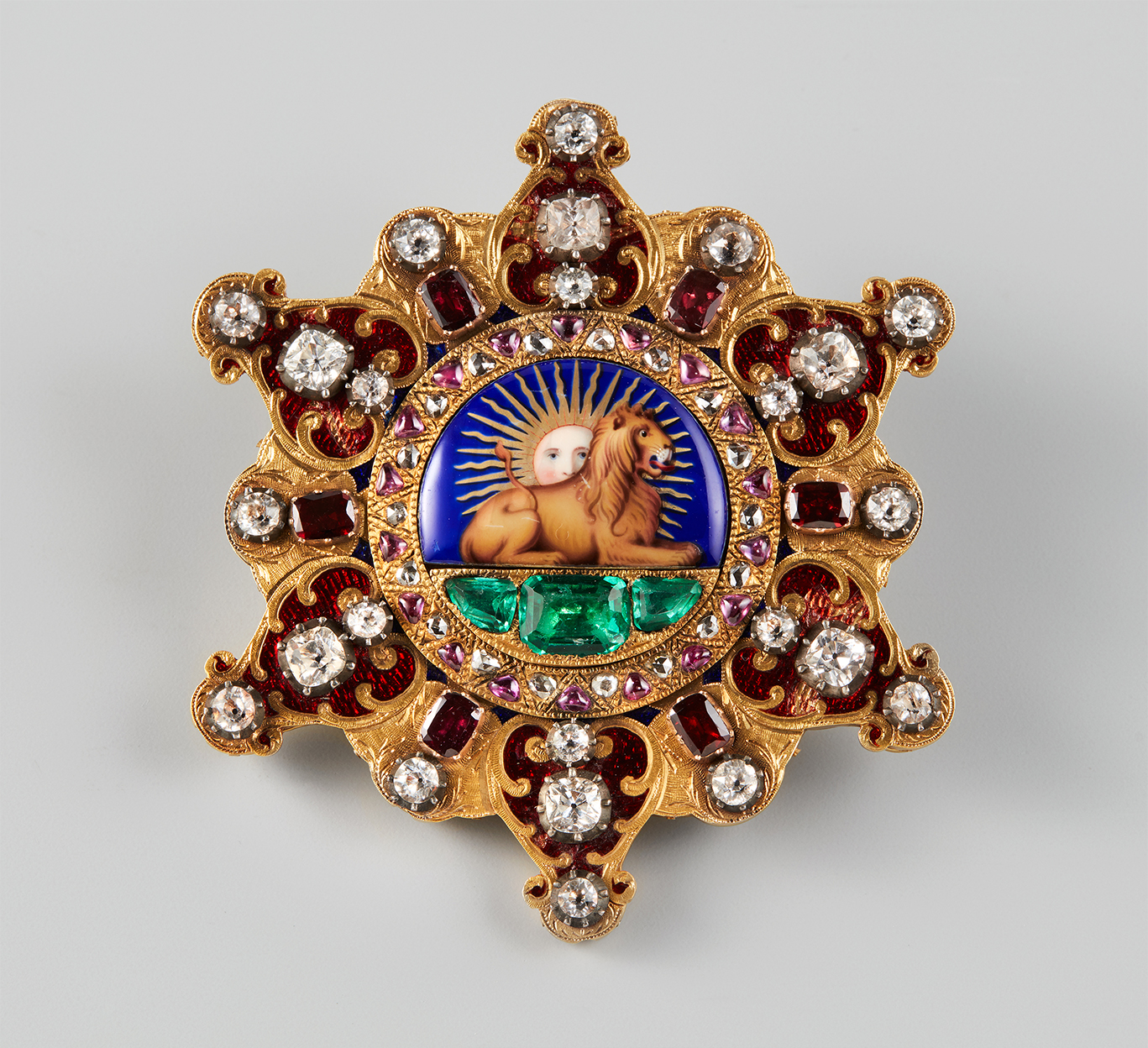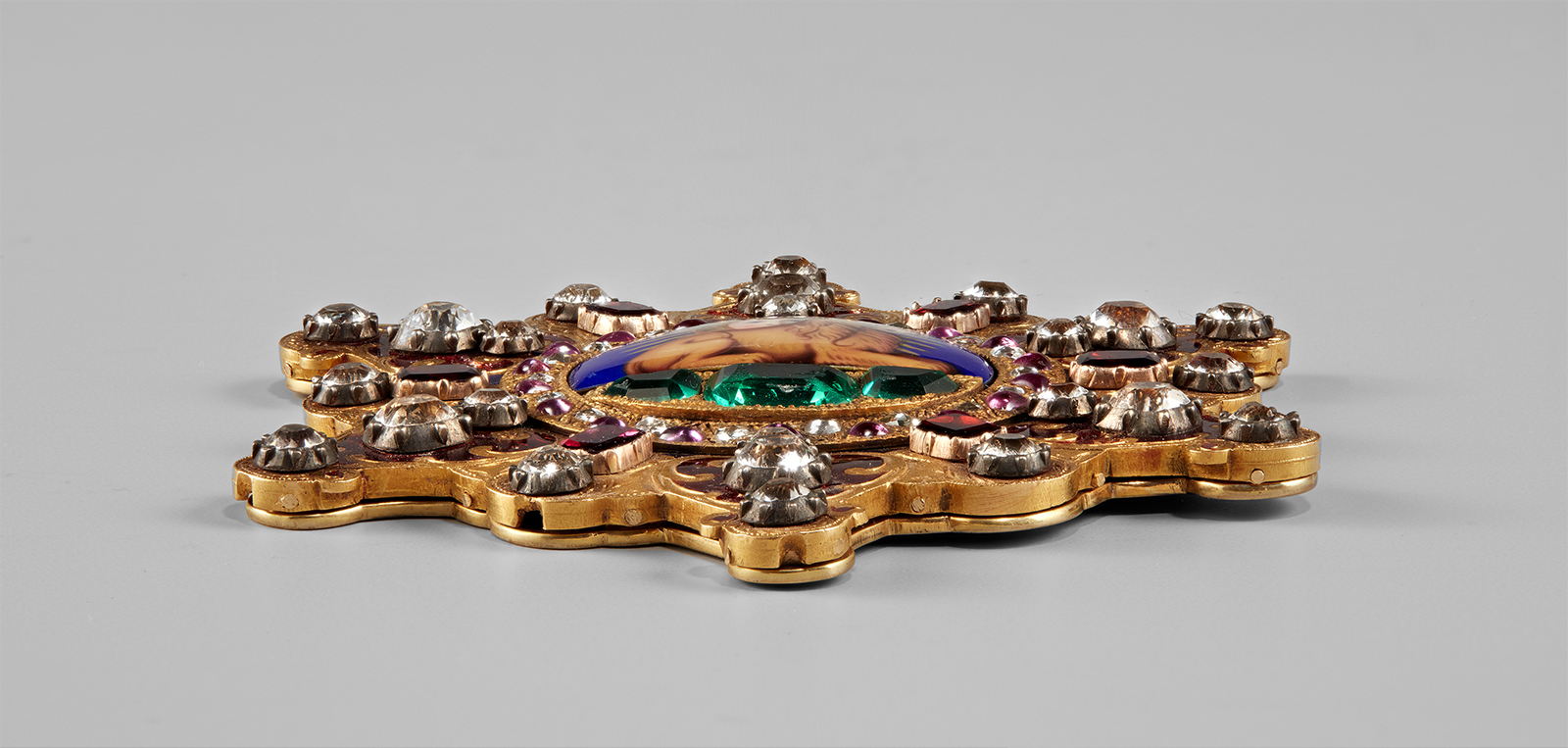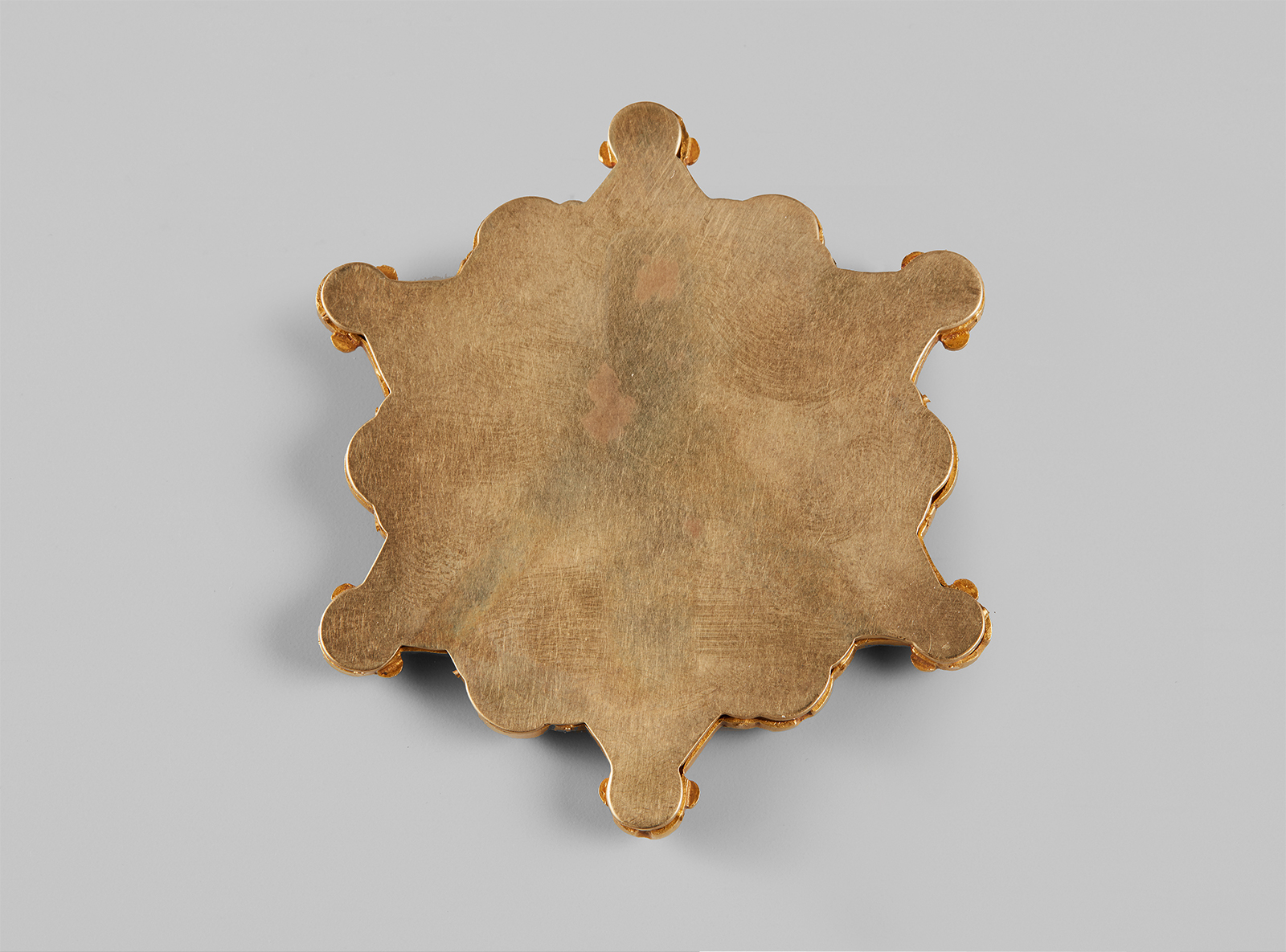Click on the image to zoom
Badge of the Order of the Lion and Sun
- Accession Number:AKM627
- Place:Iran
- Dimensions:Diameter: 7.4 cm
- Date:ca. 1840–60
- Materials and Technique:gold, enamel, set with diamonds, rubies, garnets, green glass
European-type orders of chivalry were introduced in Persia in the early 19th century and awarded to French and English diplomats who were recognized for their service to the Persian Shah. Set with diamonds and other precious gemstones, this finely painted enamel badge would have been presented to a high-ranking dignitary.
Further Reading
The first chivalric order to be introduced to Persia in the 19th century was the order of the Sun, which was modelled on the French order for military and civic merit known as Ordre national de la Légion d'honneur, established by Napoleon in 1802. The Persian Order of the Sun was instituted by Fath Ali Shah (r. 1797–1834) and awarded to a French General with whom the Shah had created an alliance in early 1807.
When the Shah wished to award this order to British officers, the officers refused to be knighted with the same badge as their enemies, the French. The court jeweller and court enameller (mīnāsāz-bāšī) of Fath Ali Shah therefore created the Order of the Lion and Sun, a variation on the badge created for the French. John Malcolm, an envoy of the English East India Company, was the first person to be awarded with this new order in July of 1810. Over the next several decades of the 19th century, the Order of the Lion and Sun was bestowed upon a number of Europeans and Persians alike.
Many varieties of the Order of the Lion and Sun were produced throughout the Qajar period (1779–1924),[1] but elaborate jewelled versions like the present example were awarded to only a select few. In extant examples of this badge, the Lion and Sun are depicted in differing arrangements; the lion may lie couchant or stand, and may be depicted facing left,[2] right,[3] or straight-on; sometimes his tail is down,[4] sometimes up; he also appears flourishing his tail with a sword in his right paw.[5] Moreover, there are deviations in the appearance of the human-faced sun peering over the lion's back, and it may be male, female, or gender-unspecified. Related objects can also be found in the Khalili collection (JLY 1631)[6] and in the Metropolitan Museum of Art (2015.55).[7] While there are few examples in museum collections, badges of the Order of the Lion and Sun have been circulating on the art market in years past.[8]
The iconography combining the lion and the sun is known in ancient Persian art and continued into the Islamic period. Referencing celestial bodies of the cosmos—the sun and the constellation Leo—these symbols were also allusions to princely attributes of strength and radiance, and for this reason considered to be protective or talismanic forms. The lion is also a symbol for ‘Ali, the son-in-law and cousin of the Prophet Muhammad, who was revered by Sh’ias of the Qajar dynasty. Ali is referred to as Lion of God, symbolizing his heroic courage.
Enamel painting is one of the signature techniques of the Qajar period, where specially trained artists used heat-fused glass paste coloured by metal oxides to finely depict figures and scenes in vibrant opaque and transparent colours. Europeans visiting Shiraz and Tabriz in the early 19th century remarked that Persian enamels were even more beautiful than those produced in Europe.[9] This badge in the Aga Khan Museum Collection is not only a remarkable work of art, but also a unique hybrid of Persian craftsmanship and European cultural influence.
— Courtney Stewart
Notes
[1] Spanning nearly a century and a half, the Qajar Dynasty (1779–1924) bridged the gap between the largely tribal society of the 18th century and a modern centralized rule in Tehran. Art produced during the Qajar period is heavily influenced by Europe, which can be seen in this object and others from the era.
[2] Bonhams, Islamic and Indian Art, 7 October 2014, Lot 124.
[3] Bonhams, Islamic and Indian Art, 7 October 2014, Lot 127.
[4] Sothebys, Arts of the Islamic World, 22 April 2015, Lot 202.
[5] Bonhams, Islamic & Indian Art, 5 October 2014, Lot 139.
[6] Spink, Michael, Jack Ogden, J M. Rogers, M G. Kramarovskii,̆ and Pedro M. Carvalho. The Art of Adornment: Jewellery of the Islamic Lands, Vol. II. London: Nour Foundation, 2013, 592.
[7] Badge of the Order of the Lion and the Sun; Iran; ca. 1920; Metropolitan Museum of Art; 2015.55. https://www.metmuseum.org/art/collection/search/669406.
[8] Bonhams, Islamic and Indian Art, 7 October 2014, Lot 127, Bonhams, Islamic and Indian Art, 7 October 2014, Lot 122, and Bonhams, Islamic and Indian Art, 7 October 2014, Lot 125.
[9] Spink, Michael et al., 586.
References
Aga Khan Trust for Culture. Spirit & Life: Masterpieces of Islamic Art from the Aga Khan Museum Collection. Geneva: Aga Khan Trust for Culture, 2007, no. 82, 115.
Berlekamp, Persis. “Symmetry, Sympathy, and Sensation: Talismanic Efficacy and Slippery Iconographies. In Early Thirteenth-Century Iraq, Syria, and Anatolia” Representations, Vol. 133, No. 1, Winter 2016, 59–109. DOI: 10.1525/rep.2016.133.1.59
EIr, Layla S. Diba, “ENAMEL,” Encyclopædia Iranica, VIII/4, 424–8. http://www.iranicaonline.org/articles/enamel.
Persian and Islamic Art: To Be exhibited by Spink & Son Ltd. Thursday 21 April – Friday 6 May 1977. London: Spink & Son Ltd, 1977.
Mulder, C. P., and Lars Stevnsborg. Persian Orders 1808–1925: The Orders of the Quajar Dynasty: Persiske Ordner 1808–1925. Kbh: Ordenshistorisk Selskab, 1990. ISBN: 978878851308
Sauvage-Smith, Emily. “Magic and Islam” and “Amulets and related talismanic objects.” In Science, Tools & Magic. London: Nour Foundation, 1997, 59–71 & 132–142. https://archive.org/details/ScienceToolsAndMagic
Spink, Michael, Jack Ogden, J. M. Rogers, M. G. Kramarovskii,̆ and Pedro M. Carvalho. The Art of Adornment: Jewellery of the Islamic Lands. London: Nour Foundation, 2013. ISBN: 9781874780861
Vernoit, S. Occidentalism: Islamic Art in the 19th Century. New York: Nour Foundation in association with Azimuth Editions and Oxford University, 1997. ISBN: 9780197276204
Wright, Denis. “Sir John Malcolm and the Order of the Lion and the Sun.” Iran, Vol. 17, 1979, 135–41. https://www.tandfonline.com/doi/pdf/10.1080/05786967.1979.11834253?needAccess=tru
---. “The Order of the Lion and Sun.” Iran, Vol. 19, 1981. 179–80. https://www.tandfonline.com/doi/abs/10.1080/05786967.1981.11834278
Note: This online resource is reviewed and updated on an ongoing basis. We are committed to improving this information and will revise and update knowledge about this object as it becomes available.






